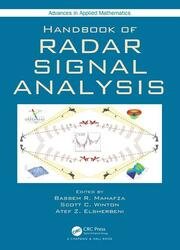Handbook of Radar Signal Analysis
- Добавил: literator
- Дата: 5-08-2021, 15:15
- Комментариев: 0
 Название: Handbook of Radar Signal Analysis
Название: Handbook of Radar Signal AnalysisАвтор: Bassem R. Mahafza, Scott C. Winton
Издательство: CRC Press
Год: 2022
Страниц: 707
Язык: английский
Формат: pdf (true)
Размер: 27.1 MB
This new handbook on radar signal analysis adopts a deliberate and systematic approach. It uses a clear and consistent level of delivery while maintaining strong and easy-to-follow mathematical details. The emphasis of this book is on radar signal types and their relevant signal processing and not on radar systems hardware or components.
This handbook serves as a valuable reference to a wide range of audience. More specifically, college-level students, practicing radar engineers, as well as casual readers of the subject are the intended target audience of the first few chapters of this book. As the book chapters progress, these grow in complexity and specificity. Accordingly, later chapters are intended for practicing engineers, graduate college students, and advanced readers. Finally, the last few chapters contain several special topics on radar systems that are both educational and scientifically entertaining to all readers.
The presentation of topics in this handbook takes the reader on a scientific journey whose major landmarks comprise the different radar subsystems and components. In this context, the chapters follow the radar signal along this journey from its birth to the end of its life. Along the way, the different relevant radar subsystems are analyzed and discussed in great detail.
The word, radar, is an abbreviation for radio detection and ranging. Radar systems use modulated bandpass radio frequency (RF) signals and directive antennas to search for targets within the radar field of view. When this RF signal is incident on a target, it interacts with the target in accordance with Maxwell’s equations, and RF energy is scattered out in all directions from the target. Some portion of the scattered energy (target return or echo) is in the direction of the radar. The radar, through its antenna, captures the echo signal and through signal processing (using specialized hardware along with signal / data processing algorithms), the radar extracts target information such as target range, target velocity, target angular position, etc. More specifically, the radar system emits a completely known waveform (signal) into free space with the expectation that a modified version of this transmitted signal scattered from the target will return to the radar.
The chapter contributors of this new handbook comprise experienced academia members and practicing radar engineers. Their combined years of academic and real-world experiences are in excess of 175. Together, they bring a unique, easy-to-follow mix of mathematical and practical presentations of the topics discussed in this book. See the "Chapter Contributors" section to learn more about these individuals.
Скачать Handbook of Radar Signal Analysis
Внимание
Уважаемый посетитель, Вы зашли на сайт как незарегистрированный пользователь.
Мы рекомендуем Вам зарегистрироваться либо войти на сайт под своим именем.
Уважаемый посетитель, Вы зашли на сайт как незарегистрированный пользователь.
Мы рекомендуем Вам зарегистрироваться либо войти на сайт под своим именем.
Информация
Посетители, находящиеся в группе Гости, не могут оставлять комментарии к данной публикации.
Посетители, находящиеся в группе Гости, не могут оставлять комментарии к данной публикации.
